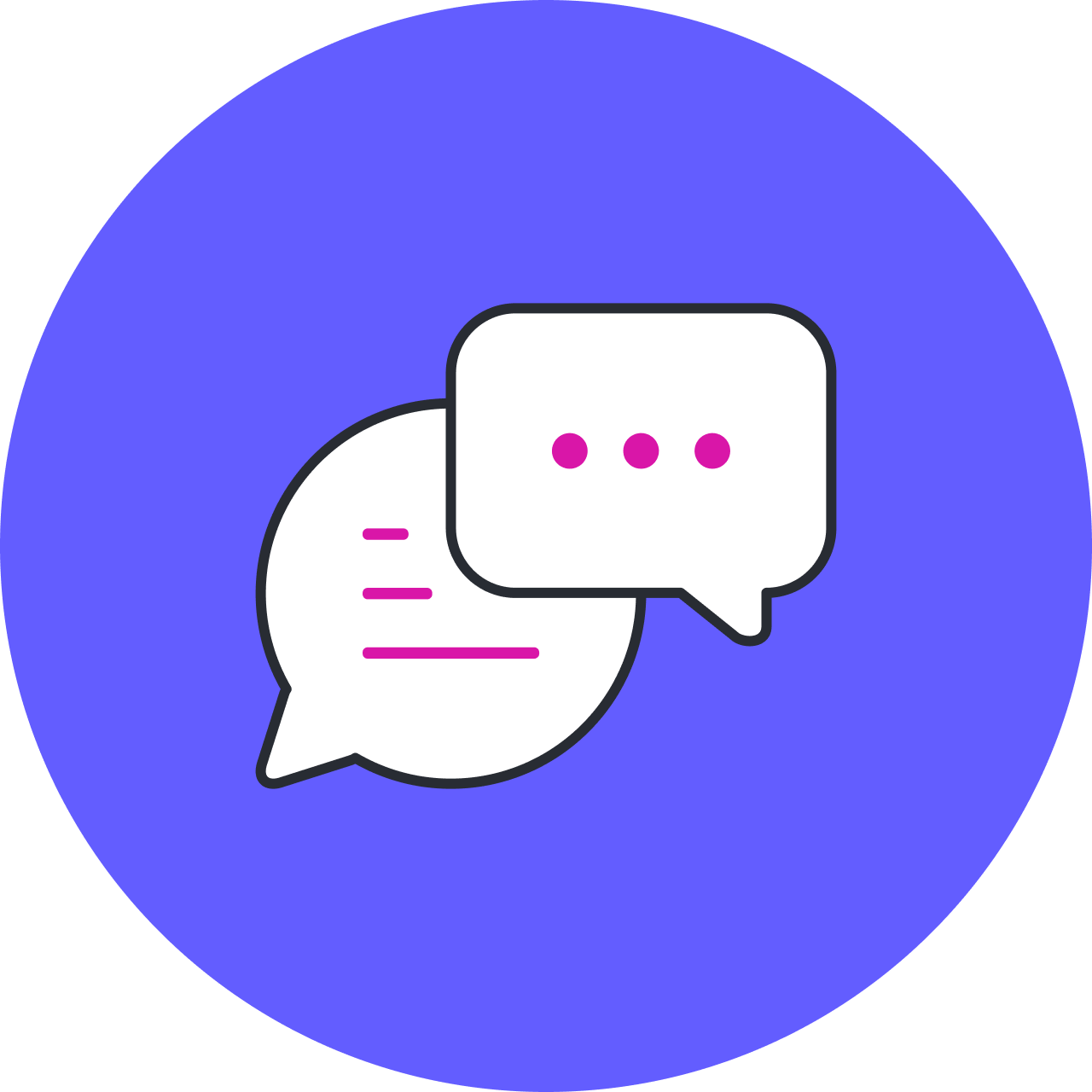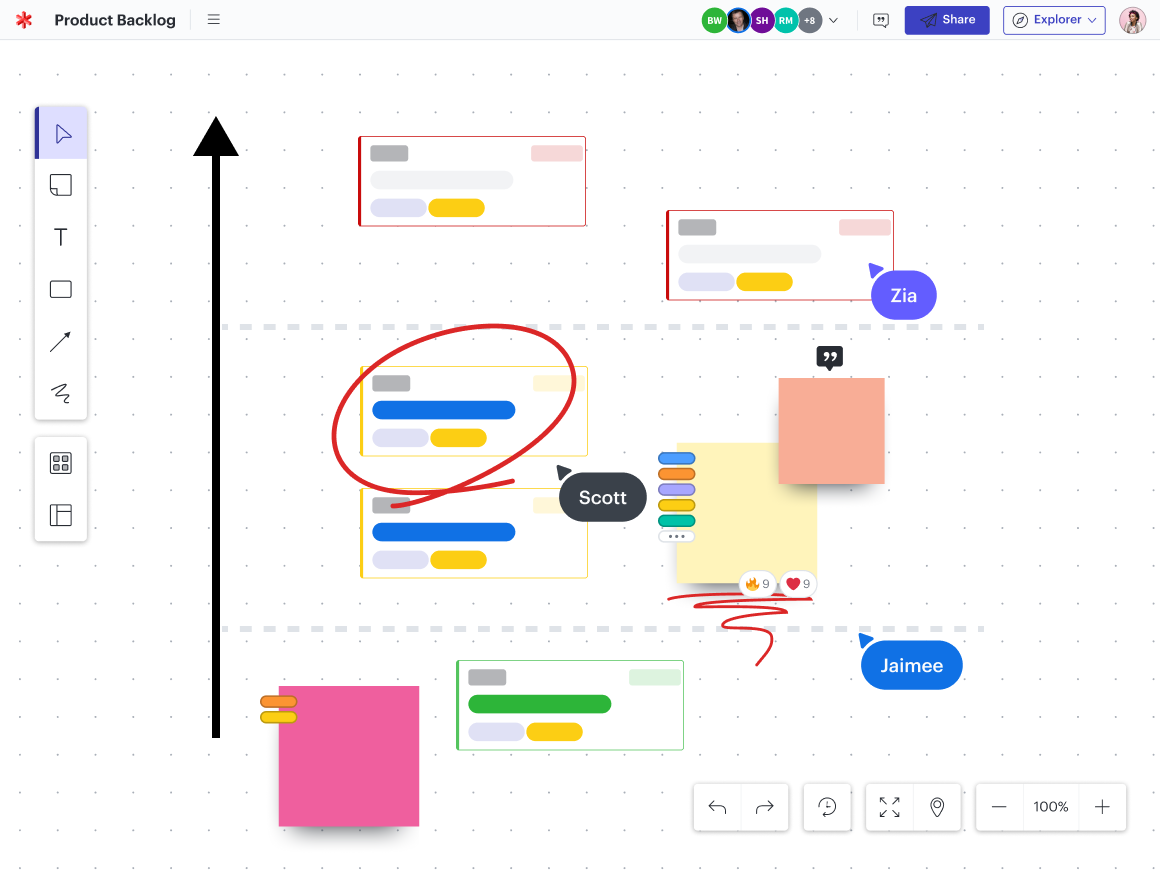
The problems with workplace collaboration today—and how to fix them
Nathan Rawlins
Reading time: about 7 min
Topics:
What comes to mind when you think of collaboration?
For many workers, it’s the idea of a group of people meeting in a conference room—or more common in recent years, a virtual call. It likely involves staring at uninspiring slide deck presentations and sifting through endless email and chat threads.
Now consider: How effective do you consider these interactions?
Given that workers today spend 58% of their time on “work about work” and 129 hours in unnecessary meetings each year, I’m willing to bet these so-called collaborative activities don’t feel too productive.
These superfluous interactions come at a high price. In an organization with 5,000 employees, research estimates that $101 million per year is potentially wasted on meetings. But collaboration should improve the bottom line, not break the bank. So what gives?
Put simply, the approach (or lack thereof) that many organizations take to collaboration is ineffective. And because it’s often difficult to determine just what’s causing collaboration to break down, it’s hard to fix it.
But teams don’t have to suffer through soul-sucking slide presentations and overcrowded inboxes. By uncovering the problems in collaboration today, we’ll reveal how much opportunity there is to collaborate better—to boost innovation, increase productivity, and accelerate revenue growth.
A brief history of the problems with collaboration
Many organizations attribute their collaboration challenges to the post-pandemic switch to remote and hybrid work. But these problems date back much further than that.
Even when teams worked in the office together every day, organizations struggled to facilitate effective collaboration. For example, years ago, I worked with an organization that felt workers were siloed by the different floors of their building and missing out on important cross-functional collaboration. They tried implementing open, central staircases and intentionally placing coffee machines on certain floors only—all in an effort to force people to interact with each other more.
Throughout the shift to remote work, organizations looked for new ways to encourage employee collaboration. These interactions often took the form of video calls, leading to a widely-experienced phenomenon called virtual meeting fatigue that’s draining employees far more than connecting them.
Whether it’s implementing an open office plan or scheduling more meetings, the problem remains the same: We’ve focused so much on increasing the quantity of interactions that we’ve neglected ways to improve the quality of these interactions. A McKinsey article put it well: “With endless meetings, incessant emails, and casts of thousands, companies have mastered the art of unnecessary interactions.”
“Hybrid work hasn’t broken collaboration. But it has made us realize that we’re at a breaking point with collaboration, and we can’t fix it with strategic coffee machine placement—or another meeting, email, or slide deck.”
What’s wrong with the current state of collaboration?
In my experience working with organizations across industries and sizes, there are a few common issues that I see with workplace collaboration. By addressing these problems directly, organizations can build the foundation of effective collaboration needed to innovate continuously and work efficiently.
Problem #1: We’re defining collaboration wrong
The first problem with collaboration today is simple: We’re thinking of collaboration wrong. More specifically, we’re conflating communication with collaboration, and we’re conflating meetings with collaboration.
When we fail to distinguish between collaboration and communication, teams end up spending a lot of time talking about work but rarely getting to a point of action. There’s a difference between sharing simple updates or asking basic questions (communication) and prioritizing ideas, planning complex projects, or designing technical solutions (collaboration).
Similarly, when we view collaboration as synonymous with meetings, we’re essentially reducing teamwork, problem-solving, and even agility to single points in time on our calendars. Meetings provide an inflated sense of productivity, keeping teams busy but slowing down actual, impactful work.

Reduce meeting fatigue
Learn how to increase efficiency and boost engagement with asynchronous collaboration.
Get the guideProblem #2: We’re not enabling collaboration with the right tools
It’s not surprising that, because we’re defining collaboration wrong, we're not enabling it properly.
While there’s no shortage of tools for communication and meetings, what teams really need is a place to share and capture ideas, clarify complex topics, and provide feedback in context. But most organizations aren’t providing the right tools to do this. So teams resort to the tools they do have available—and the result is highly inefficient.
Imagine this scenario: You’re working on identifying product requirements for a new software launch. You need to involve stakeholders across the business and decide that this would be too difficult in email or Slack, so you schedule a meeting. During the meeting, you try to capture everyone’s feedback in the only format you can think of: a spreadsheet. You spend the meeting reviewing ideas one by one, and soon the hour you scheduled is up. You leave the meeting with no clear priorities or action items and resort to scheduling another meeting to finish building the roadmap.
If all you have at your disposal is a spreadsheet, then you’re going to need a long boring meeting for every interaction.
Using outdated technology or tools that were designed for a different job—like analyzing data, not building product roadmaps—is taking its toll on employees. In fact, 29% of employees would likely accept a job elsewhere if the only difference was a better workforce tool stack.

Build your ideal collaboration tech stack
It's not about more tools—it's about the right tools.
Read moreProblem #3: We’re not treating collaboration like a skillset
When we view collaboration merely as interactions, we spend so much time trying to increase the frequency of these interactions—by placing coffee machines on certain floors, for instance. Unfortunately, that’s where many organizations have stopped. With the right conditions in place for workers to interact, collaboration should naturally flourish, right?
Not exactly. To ensure these interactions are actually meaningful and productive, organizations need to treat collaboration as a skill set. That means providing education and guidance on how to collaborate. While many organizations prioritize building technical skills like design or development, they don’t provide the same level of attention to improving skills like brainstorming, facilitation, documentation, decision-making, or giving feedback.
Focusing primarily on increasing interactions also fails to account for the many different collaboration styles across an organization. To truly increase quality, we need to build intentional skills for working with all types of collaborators—from those that do their best work on the fly to those that require more time to gather thoughts.

Get expert tips to build your team's collaboration skills.
Go nowWhat does effective collaboration look like?
Effective, high-value collaboration is measured by the quality of interactions, not quantity. In other words, every interaction has a clear purpose.
For that reason, high-value collaboration is not dictated by a cadence of meetings but rather an outcome. It’s a continuous process that flows between real-time conversation and asynchronous work based on what’s going to be most effective for the task at hand.
Let’s think back to the software launch example I gave earlier. Imagine that instead of spending an hour-long meeting just to review items in a spreadsheet, your collaborators reviewed the project ahead of the call asynchronously and left their feedback directly in context. In a 30-minute live collaborative session, you can use the feedback given to prioritize the next steps, make a decision, and walk away with clear action items. That’s high-value collaboration.

Get started with better collaboration
Of course, to break free from an endless series of meetings and make collaboration more valuable, you need the right tools and strategies.
To maximize the effectiveness of each interaction, teams need a way to clarify complex topics and reach a shared understanding quickly. One of the best ways to do this is through visual collaboration. Visual collaboration allows teams to capture all ideas, plans, designs, and decisions in one central space, making it easy to flow seamlessly between real-time and asynchronous collaboration.
Not only can visual collaboration reduce the number of meetings and emails that burden workers, but it also makes the times we do need to meet far more valuable. In other words, it helps make every interaction meaningful—allowing organizations to collaborate efficiently, innovate continuously, and improve the bottom line.
We simply can’t afford to collaborate in wasteful, outdated ways anymore. It’s time we rethink our approach to collaboration—and enable it with the right strategies, tools, and skills. Those organizations that make the change just might find that collaboration can become their competitive edge.

Transform how you collaborate
Learn how visual collaboration can set your organization apart.
Learn moreAbout the author

Nathan Rawlins joined Lucid as Chief Marketing Officer in 2017 with 20+ years of experience overseeing sales and marketing efforts across a variety of technology companies.
About Lucid
Lucid Software is the leader in visual collaboration and work acceleration, helping teams see and build the future by turning ideas into reality. Its products include the Lucid Visual Collaboration Suite (Lucidchart and Lucidspark) and airfocus. The Lucid Visual Collaboration Suite, combined with powerful accelerators for business agility, cloud, and process transformation, empowers organizations to streamline work, foster alignment, and drive business transformation at scale. airfocus, an AI-powered product management and roadmapping platform, extends these capabilities by helping teams prioritize work, define product strategy, and align execution with business goals. The most used work acceleration platform by the Fortune 500, Lucid's solutions are trusted by more than 100 million users across enterprises worldwide, including Google, GE, and NBC Universal. Lucid partners with leaders such as Google, Atlassian, and Microsoft, and has received numerous awards for its products, growth, and workplace culture.
Related articles
The evolution of collaboration: Looking back to move forward
Understand the evolution of collaboration from the last 50 years and the importance of adapting as we move forward.
6 organizational collaboration lessons to boost efficiency and engagement
Read first-hand stories about organizational collaboration, and use the takeaways to improve collaboration in your organization.
How visual collaboration strengthens operational resilience
Learn what operational resilience is, the struggles organizations currently face, and how visual collaboration can strengthen operational resilience.
What is work acceleration? Defining the next era of work
Learn what work acceleration is and why it’s becoming a core capability for organizations in an era marked by exponential change.